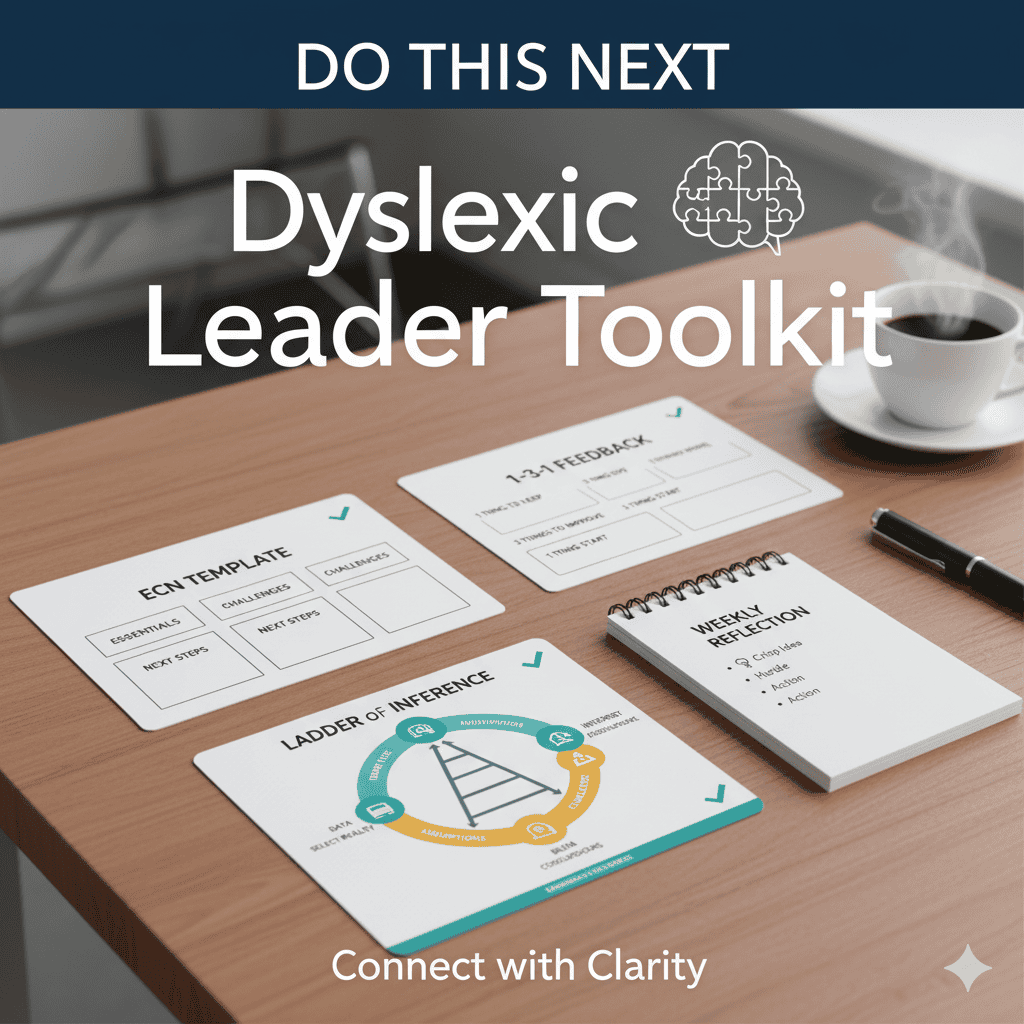Let’s clear up a long-standing myth: dyslexia isn’t just about spelling or slow reading. In fact, many dyslexic professionals possess abilities that most teams would pay good money to bottle.
• Big-picture vision — you spot connections before others even realise there’s a puzzle to solve.
• Creative problem-solving — when one door closes, you immediately look for the skylight.
• Empathy and intuition — you can read the unspoken tension in a room faster than an HR email.
• Resilience — decades of finding workarounds make you quietly unstoppable.
The real challenge is translation — helping the rest of the room see what you already know. Because these aren’t just “soft skills.” They’re leadership
The Translation Gap
Think of your brain as a Formula 1 car and your speech as the speed limit on the M1. You can think at 200 miles per hour, but you’re only allowed to talk at 70.
No wonder the corners feel tight.
Clarity doesn’t come from slamming on the brakes. It comes from having frameworks — little guiding systems that turn your lightning-fast thoughts into something others can follow.
Consider them your verbal Sat Nav. They don’t slow you down; they just help everyone else find the same destination.
Framework 1: Intent → Evidence → Next Step (The ECN Method)
A quick, no-fluff way to structure any message — meeting, email, or awkward conversation included.
Intent: “What I’d like us to achieve is…”
Evidence: “Here’s what the data tells us…”
Next Step: “So I suggest we…”
This three-step rhythm keeps everyone on the same page. It’s concise, logical, and — best of all — it builds structure as you speak. Perfect for a mind that moves faster than PowerPoint slides.
Framework 2: The 1-3-1 Feedback Formula
When giving feedback, go with this pattern:
1 positive → 3 specific observations → 1 forward action.
Example:
“Your report layout is excellent (positive). The introduction could be sharper, the charts need clearer captions, and the final slide repeats data already shown (three specifics). Let’s simplify the visuals next time (forward action).”
It turns what could be an awkward chat into a clear, constructive one — ideal for anyone who prefers facts over friction.
Framework 3: The Ladder of Inference – Catch Yourself Mid-Leap
The dyslexic mind is quick — sometimes too quick. You notice one thing, jump to a meaning, and before you know it, you’re halfway up the Ladder of Inference shouting, “He hates my idea!”
The trick is to pause halfway up and ask: “What else could this mean?”
That single question gives you time to double-check your assumptions. You’ll not only sound calmer and wiser — you’ll be calmer and wiser.
Storytelling: The Shortcut to Connection
Data convinces. Stories connect.
And here’s the thing — dyslexic thinkers are natural storytellers. You don’t see words; you see scenes. So use that to your advantage.
When explaining an idea, try the STAR method:
Situation → Task → Action → Result.
It’s your story’s skeleton — sturdy enough to carry even the wildest idea safely to the finish line.
Digital Tools That Do the Heavy Lifting
Think of technology as your personal pit crew. These tools help bridge the gap between how you think and how you communicate:
• Grammarly / QuillBot – check your writing without draining your style.
• Speech-to-text apps – talk your ideas out loud; tidy them later.
• Text-to-speech readers – proof by ear instead of eye.
• Mind-mapping tools (MindMeister, Miro) – ideal for visual planners who think in shapes, not lists.
Using tools isn’t cheating. It’s delegation — the smart kind.
Turning Fast Thinking into Clear Action
A simple three-step routine for days when your brain’s moving faster than your calendar:
1️⃣ Brain-dump – get it all out. No editing, no censoring.
2️⃣ Apply a framework – use Intent → Evidence → Next Step.
3️⃣ Polish with tech – give it a light edit or voice read-through.
In ten minutes, you’ll turn chaos into clarity — and that’s no small feat.
The Confidence Shift
Clarity isn’t about perfect grammar or immaculate slides. It’s about making your thinking easy to follow.
The moment you stop apologising for how your brain works — and start building systems that fit it — you move from coping to leading.
Workplaces don’t need fewer dyslexic thinkers. They need clearer ways to understand them.
Do This Next
Download your free Dyslexic Leader Toolkit from Connect with Clarity.
Inside you’ll find:
☑ The ECN template for sharp, structured updates
☑ The 1-3-1 feedback card
☑ A Ladder of Inference visual guide
☑ Weekly reflection prompts to keep your ideas crisp and communicable
Because the goal isn’t just to think fast — it’s to make your thinking heard.




